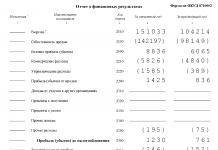Any commercial organization has a clear goal - to make money. But here people far from economics have a problem with the terms and their understanding. Profit, income, revenue - many, without thinking for a minute, mistakenly believe that these are the same thing. But profit is often used in combination with various interesting adjectives - gross, undistributed, net... The latter will be discussed below.
Net profit is one of the most important indicators characterizing the efficiency of a company. From the name it becomes clear that it represents the funds remaining at the free disposal of the enterprise. Let's discuss what formula is used to calculate it, and also consider an example of determining an indicator for a specific organization.
What is considered net profit?
In Russian reality, the idea has long been rooted that there is earnings with “clean” and “dirty” money. For example, the latter is the official salary specified in the employment contract, and the first is the amount that the employee actually receives (after paying personal income tax and other possible contributions). Although it sounds somewhat ambiguous, it reflects reality well. If we draw an analogy with net profit, the essence is absolutely the same.
– one of the main indicators informing about the results of the company’s work. It refers to the funds remaining after subtracting all expenses, including taxes, from sales proceeds and other income. It is obvious that the management of any company strives to obtain maximum net profit. Not only the owners of the enterprise and senior managers are interested in this, but also all employees, since often it is the value of this indicator that has the greatest impact on the possibilities of bonuses and incentives for personnel.
Important: As a rule, net profit goes to increase the company's working capital, the formation of various funds, industrial investments and dividends. Its volume directly depends on the organization’s gross profit and tax burden.
The amount of net profit received by an enterprise affects not only the well-being of its owners, but also the following points:
- Attracting new investors– without a doubt, they will want to invest money in the company that showed good performance results at the end of the reporting period, and net profit is a key indicator in the analysis of operating efficiency.
- Probability of getting a loan– today the harsh business reality is such that it is impossible to pull a fish out of the pond not only without difficulty, but also without attracting borrowed funds, and taking out a loan is not so easy if the net profit in the accounting documents does not please with its volumes. However, in the opposite case, money will be given without problems, and even on excellent terms.
- Maintaining the authority of the company- a reputation is made up of little things over the years: creating a name, you work for the future... Then usually everything happens, as in the joke: “For the first two years, a student works for a record, and the rest - it’s not for him.” When an organization constantly has a good net profit, this indicates its strong and stable position in the market, and hypothetical partners, as a rule, want to cooperate with such companies on a long-term basis.
- Expansion of material and technical base– in order to explore new horizons in business, it is necessary to invest money in the development of the company, which is impossible without improving technology, modernizing and purchasing new equipment, mastering current working methods, etc. And all of the above requires finance, and quite a lot of it. Where can I get them? Of course, from pure profit.
Important: if, as a result of calculations, the value of the indicator turns out to be a negative number, then the organization faced a loss in this period.
Formula for calculating net profit
Any commercial company conducting business encounters a situation where it is necessary to calculate net profit. To find its value at the end of the reporting period, you should use special formulas.
Advice: net profit is determined based on the information presented in the financial statements of the enterprise - usually it is enough to have a statement of financial results on hand.
There are several formulas that help find net profit; they have the same economic meaning, but differ in the degree of detail. Let's give the main ones.
Revenue – Cost of production – Administrative expenses – Selling expenses + Other income – Other expenses – Income tax.
If you look at the Financial Results Report, you will easily notice that each line in it has its own unique code, so the formula can be written differently:
Line 2110 – line 2120 – line 2210 – line 2220 + line 2310 + line 2320 – line 2330 + line 2340 – line 2350 – line 2410 +/– line 2430 +/– line 2450 +/– 2460.
Thus, in order to find the amount of net profit, you first need to calculate the gross profit, which is the difference between revenue and cost. As a rule, calculating the cost of goods sold is the most difficult thing for company economists, since it is determined by many components. However, even a non-specialist can cope with the calculations, especially if he familiarizes himself with the necessary information: having mastered it, it will be easier to understand how to find the net profit.
If the above formula is simplified as much as possible, we get the following:
Profit before tax – Income tax.
This calculation method is usually used by small companies that have the right by law not to apply PBU 18/02 “Accounting for income tax calculations” in their work.
Example of calculating net profit
Of course, calculating the indicator in question is somewhat more difficult to do than writing out or a delivery note, but if you have a formula, initial data and a calculator, the process will not take even a couple of minutes. Let's look at a practical example, the purpose of which is to calculate the company's net profit.
Suppose that Scarlet Flower LLC needs to find net profit for two reporting periods. The initial data is presented in the table:
| Indicator name | Amount, rubles | |
| 1st quarter 2018 | 2nd quarter 2018 | |
| Revenue | 298 000 | 355 000 |
| Cost price | 99 000 | 113 000 |
| Administrative expenses | 49 000 | 57 000 |
| Business expenses | 38 000 | 41 000 |
| Other income | 6 000 | 8 000 |
| other expenses | 11 000 | 15 000 |
| Income tax | 21 400 | 27 400 |
- Net profit (Q1)= 298,000 – 99,000 – 49,000 – 38,000 + 6,000 – 11,000 – 21,400 = 85,600 rubles.
- Net profit (Q2)= 355,000 – 113,000 – 57,000 – 41,000 + 8,000 – 15,000 – 27,400 = 109,600 rubles.
Advice: For manufacturing companies, the volume of net profit is largely determined by the cost price, and its calculation is associated with a number of difficulties - it is important not to get confused with value added tax. It won’t be difficult if you keep simple formulas in your head. You also need to ensure that all documentation is in order, since otherwise problems cannot be avoided when drawing up a balance sheet and other financial statements. There are situations when counterparties forget to attach the necessary papers to the supplied products, then it would be reasonable to send invoices to the inattentive partners to re-send the delivery notes.
What is the difference between net and retained earnings?
The difference between net profit and retained profit is that these indicators are reflected in different financial statements and do not always have equal importance, despite the popular belief regarding their equivalence.
Net profit is recorded as a separate line in the organization's financial performance report - it is recorded by any company at the end of the reporting period. Although, of course, it is possible that not everything went well, that is, instead of profit there is a loss:

Retained earnings are indicated on the liability side of the company's balance sheet:

Most often, the term “net profit” is used when talking about the profit received during the reporting period (calendar year). Retained earnings include profits not only for the reporting year, but also for the previous time.
Let's give a simple example: in the balance sheet of Vasilek LLC as of January 1, 3,200 thousand rubles are listed in the retained earnings column. Net profit for the current year amounted to 750 thousand rubles. Then:
- Retained earnings at the beginning of the reporting period = 3,200 thousand rubles.
- Net profit for the reporting period = 750 thousand rubles.
- Retained earnings at the end of the reporting period = 3,950 thousand rubles.
That is, retained profit or loss is the result of the company’s activities for the entire period of its existence, and net profit is calculated for a specific period.
Let's sum it up
Finding a company's net income is quite easy if you have access to the accounting records. Knowing the value of this indicator allows you to get an idea of how effectively the organization operates. Of course, owners strive to maximize net profit in various ways - increasing production volume, reducing costs, etc., however, sharp fluctuations in numbers can alert hypothetical investors.
At the expense of net profit, far-sighted managers usually try to expand and develop their business, since only by investing time and money in the business can they get a good result.

The main indicator reflecting the financial result of an organization’s functioning is profit. There are several basic types of profit, on the basis of which the enterprise development strategy is built.
Like any absolute indicator, profit reflects a specific value that cannot be compared with the results of other enterprises. But it is convenient to analyze profits over several periods.
Types of profit
Russian accounting identifies and accepts the following types of profit for tax purposes:
- revenue;
- gross;
- from sales;
- before tax;
- clean.
European microeconomics introduces two more types of profit into Russian practice – marginal and operating.
The basic indicator is, because it reflects the primary income of the enterprise. Further in order of decrease is (minus variable costs), (minus technological cost), from sales (minus full cost), (minus other expenses with the addition of other income and interest payable), (minus other expenses with the addition of other income), (net of taxes).
How to calculate enterprise profit
All types of profit are calculated on the basis of revenue, which is equal to the product of sales volume and unit price. Certain cost items are subtracted from primary income and thus each type of profit is found.
General calculation formulas
Revenue is found using the following formula: TR = P * Q, Where
P (price) – price, rub.;
Q (quantity) – quantity of products, rub.
Marginal profit is equal to: MP = TR – VC, Where
MP (marginal profit) – marginal profit, rub.;
TR (total revenue) – revenue, rub.;
VC – variable costs for production volume, rub.
Gross profit can be found using this formula: GP = TR – TC tech, Where
GP (gross profit) – gross profit, rub.;
TR (total revenue) – revenue, rub.;
TC tech (total cost) – technological cost, rub.
RP = TR – TC, Where
RP (realization profit) – profit from sales, rub.;
TR (total revenue) – revenue, rub.;
TC (totalcost) – total cost, rub.
Balance sheet profit is equal to: BP = RP – OE + OR, Where 
RP (realization profit) – profit from sales, rub.;
OR (other revenue) – other income, rub.;
OE (other expenses) – other expenses, rub.
OP = BP + PC, Where
BP (balanced profit) – balance sheet profit, rub.;
NP = BP – T, Where
NP (net profit) – net profit, rub.;
BP (balanced profit) – balance sheet profit, rub.;
T (taxes) – tax burden, rub.
Balance calculation formulas
The calculation data is provided in the financial results statement. Available information from the financial statements allows you to calculate the two types of profit below using one formula.
Marginal and gross profit can be found using this formula: page 2100 = page 2110 – page 2120, Where
line 2100 – gross profit, rub.;
line 2110 – revenue, rub.;
line 2120 – technological cost, rub.
Profit from sales is as follows: page 2200 = page 2110 – (page 2120 + page 2210 + page 2220), Where
line 2200 – profit from sales, rub.;
line 2110 – revenue, rub.;
(line 2120 + line 2210 + line 2220) – total cost, rub.
Balance sheet profit is equal to: page 2300 = page 2200 – page 2350 + page 2340, Where
line 2200 – profit from sales, rub.;
line 2340 – other income, rub.;
line 2350 – other expenses, rub.
Operating profit is calculated using this formula: OP = BP + PC, Where
BP (balanced profit) – balance sheet profit, rub.;
PC (percent) – interest payable, rub.
Net profit is found as follows: page 2400 = page 2300 – page 2410, Where
line 2400 – net profit, rub.;
line 2300 – balance sheet profit, rub.;
line 2410 – amount of tax burden, rub.
Examples of calculations
The company Ekran LLC is engaged in the production of drills for milling machines. Financial statements for the last 2 years contain the following data:
For this example, for 2013:
Marginal profit: MP = TR – VC = 70,000 – 25,000 = 45,000 rubles
Gross profit: GP = TR – TCtechn = 70,000 – 25,000 = 45,000 rubles
Profit from sales: RP = TR – TC = 70,000 – (25,000 + 4,000 + 13,000) = 28,000 rubles
Balance sheet profit: BP = RP – OE + OR = 28,000 – 3,000 + 800 = 25,800 rubles
Operating profit: OP = BP + PC = 25,800 + 4,000 = 29,800 rubles
Net profit: NP = BP – T = 29,800 – 29,800 * 0.2 = 23,840 rubles
For 2014:
Marginal profit: MP = TR – VC = 130,000 – 45,000 = 85,000 rubles
Gross profit: GP = TR – TCtechn = 130,000 – 45,000 = 85,000 rubles
Profit from sales: RP = TR – TC = 130,000 – (45,000 + 6,000 + 18,000) = 61,000 rubles
Balance sheet profit: BP = RP – OE + OR = 61,000 – 2,000 + 1,000 = 60,000 rubles
Operating profit: OP = BP + PC = 60,000 + 6,000 = 66,000 rubles
Net profit: NP = BP – T = 60,000 + 60,00 * 0.2 = 48,000 rubles
Profit of an enterprise as a financial result of its activities
Each type of profit is necessary to solve certain problems. Without taking them into account, a full analysis of activities is impossible. Profit is a financial result and an absolute indicator.
In other words, it can only be used for internal needs. Strategy development is based specifically on the types of profit.
If it is necessary to compare with the activities of other organizations, then profit indicators cannot be used; instead, efficiency indicators are used, for example,
Instructions
Divide the trade markup by the sum of the number one hundred with the value that is equal to the dividend. Next, multiply the total turnover by the resulting number divided by one hundred. This method is appropriate if the percentage is the same for the entire assortment. It is better to repeat the calculations several times for possible errors.
Add together the products of different turnovers and the estimated trade markup for groups of goods. Next, divide the result by one hundred. This will be successfully applied if different groups of goods are assigned different percentages for the markup.
Multiply the average percentage of gross income by turnover, and then divide by one hundred. This is the simplest markup that is applied when accounting for goods at sales prices. This method also involves calculating the average percentage of gross income. Add up the trade markup on the balance of products at the beginning of the reporting period and the markup on goods received during this time. From the result, subtract the products that are retired or have become unusable. Next, divide this number by the sum of turnover and balance at the end of the reporting period, multiplied by one hundred. Substitute the result into the first formula and calculate using the sample. Gross profit percentage is ready.
Add the trade markup on the balance of goods at the beginning of the reporting period with the trade markup received during the reporting period. Next, subtract the allowance for retired goods from the resulting number. From the result of the two previous actions, you now need to subtract the markup for the balance at the end of the working period. This method is suitable for calculating gross income based on the assortment of the remainder. But for implementation it is necessary to keep strict records of the markup for each product. Such accounting must be carried out at least once a month.
Sources:
- profit as a percentage
Budgeting can be done in three ways: bottom-up approach, top-down approach, and iterative approach. The first method primarily affects departments and projects, the second is based on the target indicators of the company's management, and the iterative method implies the presence of conditional stages. Information is distributed by management, then it is collected and summarized from below.
Calculate income received in kind. They are taken into account, however, at prices that are established and regulated by the state. Remember that income that cannot be documented will not be taken into account by credit institutions. Therefore, profit from securities is much easier to prove and include in gross income than money received from the sale of products from a personal plot. As for filling out a tax return, it is enough to simply reflect the source of income received and the total amount in order for it to be included in the tax base.
Once your total income is calculated, subtract any statutory deductions as well as expenses incurred to generate the income. Costs must also be documented. The final figure will be equal to the average annual income. If you need to get a person’s average monthly income, all that remains is to divide this amount by the actual number of months worked last year.
note
Remember that individuals must report income for the past year to the tax service by filing a declaration before April 1 of the current year.
Helpful advice
When calculating income, be guided by the Law “On Income Tax,” which establishes the amount of benefits entitled to citizens depending on their social status and level of income, which must be deducted from the total income for the year in order to obtain the taxable base.
A company's income implies the receipt of a sum of money as a result of its activities (production of goods, sales). This indicator can also increase due to securities issued by the enterprise.

Instructions
Determine what constitutes income in your company. As a rule, these are funds that were received directly from the sale of manufactured goods (produced or resold) or services. In other words, it is the profit of the organization. The second component of income is the firm's costs. They represent a certain amount of money spent in the production and sale of goods (work or services). In turn, costs can be divided into fixed (costs of paying salaries, administration and management of the company, maintaining assets, renting premises) and variable (money spent on the purchase of materials and raw materials from which the goods are produced).
Calculate the amount of taxes that the company pays for the year (this is if you need to calculate the company's income for one year). Tax can be calculated based on the tax base and the corresponding interest rate. In turn, the tax base itself is calculated based on the amount of gross income and expenses.
Calculate the income the company receives. To do this, use the following formula: enterprise income (or net profit) = gross profit - (indicator of variable costs + fixed costs) - amount of taxes.
Determine the contribution margin (the marginal or additional income a company receives from selling each additional unit of product). This income is received from the sale of goods after reimbursement of the amount of variable costs. In order to calculate the value of this indicator, use the formula: TR - TVC, where TR is the amount of income, TVC is the amount of variable costs. Thus, the amount of marginal income will imply the amount of the company intended to cover all fixed expenses, as well as the formation of net arrived.
Video on the topic
The ultimate goal of any commercial company is to generate income. Profit in general represents the excess of income over expenses. In other words, this is the part of the proceeds that remains after covering costs and is used to increase fixed capital.

Instructions
A company's profit is the positive financial difference that remains at its disposal after covering production costs, paying off debt obligations and paying shareholders. This is surplus income that goes in addition to fixed capital and is invested in the further development of the company.
Gross amount of revenue from sales of products. Net income is calculated by subtracting from this value the cost of all goods returned by consumers, as well as discounts provided to customers through special promotions or discount programs.
The cost of finished products includes the cost of purchasing and delivering equipment and raw materials, paying employees of the company and other costs associated with the production and promotion of goods to the market.
To assess the efficiency of a company's business activities, the net profit indicator is taken. This value is equal to the difference between gross profit and the amount of taxes paid and other mandatory payments to government bodies (fines, excise taxes, payment of certificates, permits, etc.). There is also a distinction between accounting and economic profit.
The accounting profit of a company is the totality of income calculated from the balance sheet. This indicator takes into account only those financial transactions for which official accounting transactions were made between the relevant accounts. This type of profit does not take into account the amount of lost profits (the opportunity cost of a product or service).
Economic profit is obtained from accounting profit by subtracting the amount of additional costs, for example, payment of bonuses to employees, opportunity cost. The indicator of economic profit can serve to assess the efficiency of using the company's material assets and provides a more detailed understanding of the relationship between the actual funds spent and the financial result obtained.
Video on the topic
The purpose of existence of any commercial organization is to make profit from its activities. There is a methodology for calculating taxable profit, in which all income and expenses recognized for tax accounting purposes are clearly regulated. Simply put, the profit calculation formula is the difference between an organization's income and expenses.

Instructions
The amount of profit is calculated in stages for tax purposes. The key concept in calculating the amount of profit is revenue. It includes all amounts that the organization received from the sale of its goods, the provision of any services or work, and other receipts of money to the personal account and cash register of the organization related to its normal activity.
In the balance sheet, reflect the revenue in line 2110 of the “Profit and Loss Statement.” Find its amount by subtracting from the total amount on the credit of account 90-1 “Revenue” the amounts of export duties, excise taxes and VAT, which are reflected in the debit of subaccounts 90-4, 90-5 and 90-3. The resulting value will be the starting point for further calculation of the amount of profit.
From this amount of revenue for the period for which the calculation is being made, subtract , that is, the initial costs for carrying out the main activity. This way you will get what is called gross profit. If you then subtract the amount of money the organization spent on administrative and selling expenses from gross profit, you get a figure that reflects the profit (or in some cases, loss) on sales.
Profit from sales is one of the most important indicators characterizing the performance of any company. It is used not only by trade organizations, but also by any commercial enterprises. Read how to calculate profit from sales.
What is sales profit
Profit from sales is an indicator that characterizes the performance of any company. It is of exceptional importance both for internal users (for example, for company management) and for investors. Based on the profit from sales indicator, business managers form management decisions, and investors, in turn, evaluate the prospects of the enterprise from the point of view of possible investments.
In fact, profit from sales is the amount of money that will remain at the disposal of the company if we subtract from all income earned by the enterprise, as well as commercial management expenses attributable to the corresponding time interval.
Download and use it:
How to determine break-even sales volume
See how to determine what sales volume should be in physical terms for revenue to fully offset costs. We will tell you how to find the break-even point for single-product companies and enterprises with a wide range of products.
Example 1. How to calculate profit from sales
Let’s assume that the profit from the sale of the factory for the production of Christmas tree toys “Magic Sparkle” amounted to 627 thousand rubles. with revenue of 2120 thousand rubles. and total cost 1493 thousand rubles. Let's determine what the revenue of a factory for the production of Christmas tree decorations should be to achieve a sales profit of 750 thousand rubles.
Suppose that with an increase in sales profit by 1 ruble, the total cost increases by 40 kopecks. Let's calculate how much the total cost will increase.
To do this, we first determine how much profit from sales should increase.
∆Profit = 750 - 627 = 123 thousand rubles.
Therefore, with an increase in sales profit by 123 thousand rubles. the total cost will increase by:
123000 * 0.40 = 49,200 = 49.2 thousand rubles.
Thus, for sales profit to reach 750 thousand rubles, the revenue indicator must be equal to:
Exp1 = 750 + 1493 + 49.2 = 2292.2 thousand rubles.
Example of calculating profit from sales No. 2
The performance indicators of Magic Sparkle were (thousand rubles), see the table.
Table. Performance indicators of the Magic Sparkle factory
We'll tell you how to determine profit from sales, using gross profit as a basis:
For 2015: 2120 - (1135 + 246 + 112) = 627 thousand rubles.
For 2016: 2320 - (1246 + 297 + 153) = 624 thousand rubles.
Now let’s find the profit from sales, taking profit before tax as a basis:
For 2015: 516 + 129 – 27 + 9 = 627 thousand rubles.
For 2016: 547 + 96 – 19 – 49 = 624 thousand rubles.
How to calculate profitability (ROI)
Information about the value of profit from sales makes it possible to determine (profitability, efficiency of use). The calculation formula is universal - profitability is defined as the quotient of the profit from sales divided by the average value of the indicator whose profitability needs to be calculated.
So, to determine profitability non-current assets (production assets) of the company, it is necessary to divide the profit from sales by the total of section 1 of the balance sheet.
Calculation example No. 3
Let us turn to the results of the Magic Sparkle factory.
As we already found out earlier, the profit from sales for 2016 amounted to 624 thousand rubles, and for 2015 – 627 thousand rubles.
Let’s assume that the value of non-current assets at the beginning of 2016 amounted to 2281 thousand rubles, and at the end – 1897 thousand rubles.
Then the profitability of production assets in 2016 will be equal to:
624 000 / ((2281 + 1897) / 2)) * 100% = 29,87%
Now let’s assume that the value of production assets at the beginning of 2015 amounted to 2,428 thousand rubles, and at the end – 2,281 thousand rubles.
Let's determine the profitability of production assets for 2015:
627 000 / ((2428 + 2281) / 2) * 100% = 26,63%
Information about net profit value from sales also makes it possible to determine such .
To determine this indicator, sales profit is divided by sales volume (revenue) for a certain period.
In fact, the profitability formula reflects the algorithm for calculating profit (loss) as a percentage per 1 ruble of the organization’s revenue.
Profitability calculation example No. 4
Let us turn to the results of the MagicSparkle factory. As we have already found out, the company’s sales profit for 2016 amounted to 624 thousand rubles.
Then the return on sales of Magic Sparkle for 2016 will be equal to:
624 000 / 2320 = 26,9%
As for the profitability of sales for 2015, it will be:
627 000 / 2120 = 29,58%
The results obtained allow us to conclude that sales profitability decreased in 2016. The company's management needs to determine what factor caused this decrease and adopt measures that allow optimizing the company's cost structure.
It should be noted that each industry is characterized by a certain average rate of profitability and the profitability values of companies operating within the same industry, with some exceptions, correspond to this standard.
Analysis of the influence of other indicators on the amount of profit from sales
In order to understand what role certain factors played in the formation of sales profits, the so-called factor analysis is traditionally used, which makes it possible to determine the degree of influence of a particular factor (see, for example, about ).
To do this, first determine the growth rate of a certain indicator as a percentage using the formula:
Tgrowth = ϕ1 / ϕ2 * 100 - 100,
where ϕ1 is the value of the indicator at the end of the analyzed period, and ϕ2 – at the beginning of the period.
An example of analyzing the impact on sales profit of other indicators
Based on the data from the profit and loss report of the MagicSparkle factory, we will determine what impact the growth in revenue and the increase in cost of sales had on the amount of profit from sales.
1. Let’s determine what role revenue growth played in the change in profit for 2016:
Let's calculate the change in revenue for 2016:
∆Expert = Exit (2016) - Exit (2015) = 2320 - 2120 = 200 thousand rubles.
Let's determine the sales growth rate for 2016:
Tvyr = Vyr (2016) / Vyr (2015) * 100 - 100 = 2320 / 2120 * 100 - 100 = 9.43%
Now let’s calculate what impact revenue growth had on the change in sales profit for 2016.
∆PribProd (Vyr) = Tvyr * PribProd (2015) / 100 = 9.43% * 627 / 100 = 59.13 thousand rubles.
Thus, due to an increase in revenue by 200 thousand rubles. profit from sales of the factory for the production of Christmas tree decorations "MagicSparkle" increased by 59.13 thousand rubles.
2. Let’s determine how the increase in cost of sales affected the sales profit indicator.
Let's calculate the change in cost for 2016:
∆Sebest = Sebest (2016) - Sebest (2015) = 1246 - 1135 = 111 thousand rubles.
Let's determine the rate of increase in cost for 2016:
Tsebest = Sebest (2016) / Sebest (2015) * 100 - 100 = 1246 / 1135 * 100 - 100 = 9.78%
Let's determine the impact of an increase in cost on sales profit for 2016:
∆PribProd (Sebest) = -Tsebest * PribProd (2015) / 100 = -9.78% * 627 / 100 = -62.32 thousand rubles.
Thus, due to an increase in cost of sales by 111 thousand rubles. sales profit for 2016 decreased compared to 2015 by 62.32 thousand rubles.
In a similar way, you can determine the impact of changes in each factor on sales profit. In this case, the total change in profit from sales will be equal to the sum of the changes that occurred due to the influence of each factor.
Making a profit is the goal of any commercial enterprise. In economic analysis, several types of profit are used, depending on which cost groups are included in the calculation. But in practice, business owners and investors are primarily interested in net profit. Let's look at why this indicator is so important and how to calculate net profit.
Net profit concept
Net profit is understood as the financial resources remaining at the disposal of the enterprise after all the expenses necessary for the operation of the enterprise have been made and mandatory payments to the budget have been made. Net profit, by decision of the owners, can be used to pay dividends, or partially or fully invested in business development.
This indicator is one of the key indicators when assessing the company's performance by its owners. External users of information about the enterprise (for example, investors or banks) are also primarily interested in such an indicator as net profit. The formula for calculating net profit includes all the main indicators characterizing the results of the organization's activities. How to find net profit - we will consider in the next section.
How to calculate net profit - formula
Calculation of net profit is the final stage of summing up the results of the enterprise's activities. It is necessary to already know all the basic economic indicators in order to calculate net profit. The formula showing how net profit is calculated generally looks like this:
PP = B – SS – KR – UR + PD – PR - NP + (-) NR
Let's consider each of the indicators that the above net profit formula includes.
B – sales revenue. This article includes all income of the organization from its core activities.
CC – cost of sales. These are costs directly related to production or sales. For a trading company, this article includes the cost of purchasing goods, and for a manufacturing company - direct costs of production (materials, workers' wages, electricity, etc.).
CR – commercial expenses. This item includes the costs of selling products (goods). In particular, this includes wages for commercial service workers, advertising, freight transport services, warehouse maintenance, etc.
UR – management expenses. This item includes the costs of managing the enterprise. This includes salaries for management personnel, maintenance of office space and passenger transport, information and consulting services, etc.
PD – other income. This item includes income not related to the main activities of the company. For example, a manufacturing company may rent out unused workshops.
PR - other expenses. This article is similar in economic meaning to the previous one and contains expenses not related to the main activity. This could be, for example, bank services or exchange rate differences.
NP – income tax.
NR – tax differences. This article takes into account deviations between profit according to accounting and tax accounting data. They can arise, for example, due to different methods of calculating depreciation. Tax differences can either increase or decrease profits, depending on the methods adopted by the enterprise for accounting for certain types of costs.
How to calculate net profit based on financial statements
The main source of information about the results of an enterprise's activities for external users is financial statements. All items of income and expenses listed in the previous section are contained in the statement of financial results (form No. 2). This report can be considered a clear example of how to calculate net profit. The formula for calculating it according to the lines of form No. 2 is as follows:
Page 2400 = page 2110 – page 2120 - page 2210 - page 2220 + page 2340 – page 2350 – page 2410
Net profit can also be seen in the balance sheet, but not in such an explicit form as in form No. 2. To do this, you need to calculate the difference in the values of the “Retained earnings” indicator (line 1370) for adjacent reporting dates. This difference will correspond to net profit for the period between these dates. But here it should be noted that this method does not always allow one to correctly determine net profit, but only in the case when during the billing period there was no distribution of profit between the founders or other use of it (for example, the formation of funds).
Conclusion
One of the main indicators characterizing the performance of a commercial organization is net profit. The formula for its calculation includes all items of income and expenses of the enterprise. Net profit shows what funds business owners can have after transferring all mandatory payments. In financial statements, net profit is most easily determined from the income statement.


















